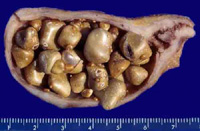|
 The gallbladder concentrates
and stores bile for eventual release into the duodenum. It has a
highly folded mucosa that is lined by simple columnar
epithelium with an underlying lamina propria. The gallbladder
does not have a true submucosa. Rather, it has a muscularis
in which the muscle layers are interspersed with connective tissue
fibers. An adventitia surrounds the gallbladder where it lies
against the liver and a serosa is present where it’s not in contact
with other organs. The simple columnar epithelium lining the cavity
of the gallbladder is highly specialized for active transport of
water, possessing abundant microvilli, mitochondria, and Na+ pumps
in its basolateral plasma membranes. These features facilitate the
concentration of bile. The gallbladder concentrates
and stores bile for eventual release into the duodenum. It has a
highly folded mucosa that is lined by simple columnar
epithelium with an underlying lamina propria. The gallbladder
does not have a true submucosa. Rather, it has a muscularis
in which the muscle layers are interspersed with connective tissue
fibers. An adventitia surrounds the gallbladder where it lies
against the liver and a serosa is present where it’s not in contact
with other organs. The simple columnar epithelium lining the cavity
of the gallbladder is highly specialized for active transport of
water, possessing abundant microvilli, mitochondria, and Na+ pumps
in its basolateral plasma membranes. These features facilitate the
concentration of bile. Examine
the image at the right and these two sections of gall bladder (sample
1, sample 2 ). ).
- Identify
the major layers (mucosa, muscularis, and adventitia).
- Note the
prominent mucosal folds.
- Also note the simple columnar epithelium (SCE)
lining the cavity and underlying lamina propria (LP).
 Clinical
note: A common disorder of the gallbladder is cholelithiasis or
the formation of gallstones. These are concretions of cholesterol
monohydrate, calcium salts, and phospholipid, which can cause
painful inflammation of the gallbladder and/or obstruction of the
cystic duct and distention of the gallbladder. Treatment often
involves surgical removal of the gallbladder. Clinical
note: A common disorder of the gallbladder is cholelithiasis or
the formation of gallstones. These are concretions of cholesterol
monohydrate, calcium salts, and phospholipid, which can cause
painful inflammation of the gallbladder and/or obstruction of the
cystic duct and distention of the gallbladder. Treatment often
involves surgical removal of the gallbladder.
Now for the
pancreas. |